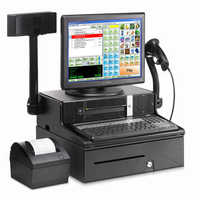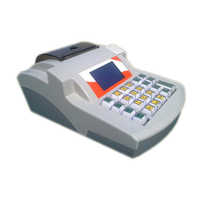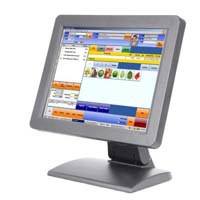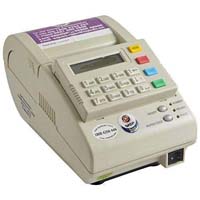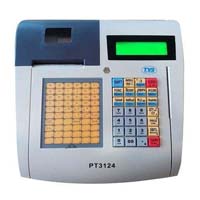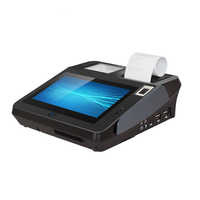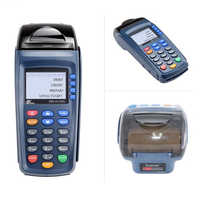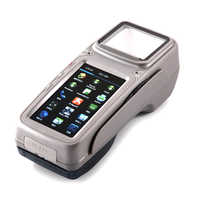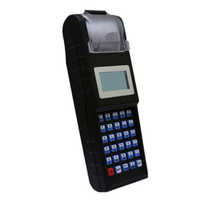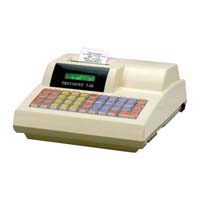Billing Machine
(583 products)
Top Billing Machine Categories
Explore More Categories
Essae Pos-816J Pos Touch Screen Memory Size: 4Gb Ddr4 Ram 1 X So-Dimm Slot (Expandable Up To 32Gb) Gigabyte (Gb)
Price Trend: 1.00 - 1.00 INR (Approx.)/Number
MOQ - 1 Number
Weight - 5.3 Kilograms (kg)
Power Supply - DC 12 V / 5 A , 60 W
Product Type - pos touch screen
5 Years
Business Type: Manufacturer | Exporter
ESSAE TERAOKA PRIVATE LIMITED
Pos Touch Screen System Usage: Retail Store
Price: 32000 INR (Approx.)/Piece
MOQ - 01 Piece/Pieces
Usage - Retail Store, Receving, wareshousing
Product Type - POS System
3 Years
Business Type: Manufacturer | Distributor
HONESTATTVA IT SOLUTIONS PRIVATE LIMITED
Made in India
Point Of Sale System
Price: 50000 INR (Approx.)/Piece
MOQ - 1 Piece/Pieces
Printer Type - Point of Sale System
Feature - Barcode, Waterproof, Anti-Counterfeit, Heat Sensitive, Holographic, Self-Adhesive, Antistatic, Scratch-Off, Moisture Proof, Recyclable, Scratch Off, Anti-Curl, Recycled Materials
Type - Scanner
5 Years
Business Type: Manufacturer | Supplier
SMART BARCODE SOLUTIONS
Black G-Slim Touch Pos System
Price: 45000 INR (Approx.)/Piece
MOQ - 1 Piece/Pieces
Usage - Commercial
Power Supply - Electric
Screen Size - 15 Inch (in)
2 Years
Business Type: Manufacturer | Distributor
ACURAL SOLUTIONS PRIVATE LIMITED
Indian Inquiries Only
Made in India
Naje- Star Electronic Billing Machine Voltage: 220-240 Volt (V)
Price: 17000 INR (Approx.)/Piece
MOQ - 1 Piece/Pieces
Installation - Table Mount
Product Type - Billing Machine
Power Supply - Elctric
Business Type: Manufacturer | Supplier
ATSET INTERNATIONAL
Made in India
Essae Pos 615C Corei3 11Th Generation - Color: Black
Price: 121020 INR (Approx.)/Unit
MOQ - 1 Unit/Units
Current - 12V, 5A Volt (v)
Color - Black
Paper Size - 80mm
2 Years
Business Type: Service Provider | Trading Company
TOUCH INFOMATICS
Made in India
White Retail Shop Electronic Billing Machine
Price: 18500 INR (Approx.)/Piece
MOQ - 1 Piece/Pieces
Usage - Restaurant
Product Type - Retail Shop Electronic Billing Machine
Color - White
2 Years
Business Type: Manufacturer | Service Provider
MARUDHAR THREAD MILLS
Advantech J1900 Touch Screen Pos System Usage: Commercial
Price: 25000 INR (Approx.)/Unit
MOQ - 10 Unit/Units
Installation - Normal
Usage - Commercial
Power Supply - Electricity
2 Years
GLOBAL INFOTECH SOLUTIONS
Made in India
Portable Digital Billing Machine
Voltage - 220 Volt (v)
Installation - Table Top
Usage - Used for billing
1 Years
Business Type: Service Provider | Trading Company
Spinners Technologies
Shops NS Pro POS Billing Machine
Price: 45000 INR (Approx.)/Piece
MOQ - 1 Piece/Pieces
4 Years
Business Type: Trading Company
WEIGH SHOPPE
Indian Inquiries Only
Billing Machine For Cash Counters
8 Years
Business Type: Manufacturer | Service Provider
ANNANYA INDUSTRIAL EQUIPMENTS
Indian Inquiries Only
Wep Bp 2100 Billing Machines Usage: Commercial
Price: 27000.00 INR (Approx.)/Unit
MOQ - 1 Unit/Units
Usage - Commercial
Power Supply - Electricity
Product Type - Billing Machine
3 Years
Business Type: Trading Company
UNIK BUSINESS SOLUTION
Indian Inquiries Only
Tvs Touch Android Pos System With Billing Software With Pos Printer Usage: Commercial
Price: 19000 INR (Approx.)/Unit
MOQ - 10 Unit/Units
Printer Type - Billing Machine
Installation - Normal
Power Supply - Electricity
2 Years
Business Type: Supplier | Trading Company
Dynamic Solution
Indian Inquiries Only
Black Wep Th 400 Plus Thermal Retail Billing Printer
Price: 10000 INR (Approx.)/Number
MOQ - 1 Number
Color - Black
Memory Size - N/A
Power Supply - 220v
6 Years
Response Rate: 86.59%
Business Type: Exporter | Service Provider
BITSONLINE TECHNOLOGIES
Pos-615 Core I3 11Th Gen Processor Pos System Screen Size: 1024 X 768 Inch (In)
Price: 82000 INR (Approx.)/Piece
MOQ - 100 Piece/Pieces
Cash Drawer - No
Product Type - Pos System
Screen Size - 1024 x 768 Inch (in)
Business Type: Distributor | Supplier
Sonic Computech
Black Thinpc 156C-J1900 Pos Touch Screen
Price: 35000 INR (Approx.)/Unit
MOQ - 1 Unit/Units
Power Supply - Electric
Voltage - 12 Volt (v)
Usage - Commercial
3 Years
Business Type: Trading Company
EUNIQUE SOLUTIONS
Indian Inquiries Only
Made in India
White Automatic Balaji Billing Machine
Price: 12650 INR (Approx.)/Unit
MOQ - 1 Unit/Units
Usage - Commercial
Current - 230 Volt (v)
Color - White
2 Years
Business Type: Distributor | Service Provider
HBS Automation Pvt. Ltd.
Indian Inquiries Only
As Per Req. Fanless High Performance Pos System Hardware
MOQ - 1000 Unit/Units
Usage - Commercial
Installation - Free standing
Product Type - Fanless High Performance POS System Hardware
Business Type: Manufacturer | Distributor
Fametech Inc.
Pos I 720 Essae Billing Machine Voltage: 230 Volt (V)
Price: 29000 INR (Approx.)/Unit
MOQ - 1 Unit/Units
Voltage - 230 Volt (v)
Product Type - POS I 720 Essae Billing Machine
Power Supply - Elctric
2 Years
Business Type: Manufacturer | Distributor
Vartech Weighing Systems Private Limited
Made in India
Black Windows Pos Machine With Cash Drawer Port
Price: 50000 INR (Approx.)/Piece
MOQ - 1 Piece/Pieces
Usage - Commercial
Product Type - Windows POS Machine With Cash Drawer Port
Screen Size - 15.6 Inch (in)
2 Years
Business Type: Manufacturer | Exporter
Shreyans Retail Solutions
Made in India
Black All In One Pos System Bundle
Price: 62000 INR (Approx.)/Set
MOQ - 1 Set/Sets
Color - BLACK
2 Years
Business Type: Trading Company
Sync Infosys
Made in India
Pass ND Billing Machine
Price: 25000 INR (Approx.)/Unit
MOQ - 1 Unit/Units
Installation - Normal
Power Supply - Electric
Color - As Per Requirement
Business Type: Manufacturer | Distributor
TEKONE TECHNOLOGYS
Indian Inquiries Only
Partner POS Systems And Solutions Device
Price: 40000.00 INR (Approx.)/Piece
MOQ - 1 Piece/Pieces
Weight - 5.00 Kilograms (kg)
Product Type - POS Systems
Color - Black White
Business Type: Manufacturer | Distributor
SCAN INDIA
Indian Inquiries Only
Multi Color 12 Votlage Semi Automatic Billing Machine
Price: 11000 INR (Approx.)/Piece
MOQ - 2 Piece/Pieces
Screen Size - 9 Inch (in)
Product Type - billing_machine
Memory Size - 32 Gigabyte (GB)
Business Type: Supplier | Exporter
Shivangi Enterprises Pvt. Ltd.
Black Billing Machine
Price: 18500 INR (Approx.)/Piece
MOQ - 1 Piece/Pieces
Paper Size - 79mm
Cash Drawer - connetivity
Installation - Free installation
Business Type: Supplier | Trading Company
UJWAL ASSOCIATES
Indian Inquiries Only
Digital Electronic Billing Machine
Price: 12000 INR (Approx.)/Unit
MOQ - 1 Unit/Units
Color - White
Usage - Billing machine
Product Type - Electronic Billing Machine
Business Type: Manufacturer
Balaji Printouch Solution
Nukkad Shops Aspire for Retail
Price Trend: 40000.00 - 55000.00 INR (Approx.)/Unit
MOQ - 1 Unit/Units
Response Rate: 90.91%
Business Type: Supplier | Service Provider
NUKKAD SHOPS TECHNOLOGIES (INDIA) PRIVATE LIMITED
Black Trucount Zip 20 Electronic Billing Machine
Price: 15000 INR (Approx.)/Piece
MOQ - 1 Piece/Pieces
Color - Black
Usage - Restaurant
Business Type: Manufacturer | Trading Company
GARG SCALE WORKS
Billing Machine Manufacturers | Suppliers in India
| Company Name | Location | Member Since |
|---|---|---|
| Annanya Industrial Equipments | Gurugram, India | 8 Years |
| Bitsonline Technologies | New Delhi, India | 6 Years |
| Essae Teraoka Private Limited | Bengaluru, India | 5 Years |
| Smart Barcode Solutions | Ahmedabad, India | 5 Years |
| Weigh Shoppe | Korba, India | 4 Years |
| Honestattva It Solutions Private Limited | Ahmedabad, India | 3 Years |
| Unik Business Solution | Indore, India | 3 Years |
| Eunique Solutions | Ghaziabad, India | 3 Years |
| Acural Solutions Private Limited | Delhi, India | 2 Years |
| Touch Infomatics | Delhi, India | 2 Years |
Introduction Of Billing Machine
How Does a Billing Machine Work?
- Turn on the billing machine.
- Use the keypad to enter the item's code when the buyer requests to purchase a certain item.
- Press "Enter" after entering the item's code.
- Describe the amount. This figure indicates how many products the client purchased.
- Look up the details on the screen to see if you entered the correct numbers.
- Once you've finished, click "Print." You can hand the buyer the bill once it is ready.
Types of Billing Machine
They are mobile and have batteries as well as a display bar.
This variety is more useful in stores, lodging facilities, or any other location where you can give them some room.
Features Of An Effective Billing Machine
- The following qualities should be present in an efficient billing device:
- It makes creating bills quick and simple.
- It keeps meticulous records of payments and flags those that are past due.
- It safely obtains the client account information and discount points from its database.
- It is inexpensive. When considering the long term, one should spend money on quality billing software because it will end up costing the company less overall.
- Each item and service it provides has a billing code. Codes make it possible to determine the most popular items with buyers. Providing codes aids with inventory management as well.
- It accepts several payment methods, including Paytm and plastic money.
Advantages Of Using Billing Machine
FAQs: Billing Machine
Related Categories
Billing Machine
Calculator
Diaries & Calendars
Education Appliances
Educational Aids
Fax Machines
Graph Plotter
Microfilm Equipment
Office Consumables
Office Equipment & Supplies
Office Furniture
Office Supplies Agents
Optical Instruments & Devices
Paper & Paper Boards
Paper Shredders and Cutters
Pen & Pencils
Photocopiers
Photography & Filmmaking Equipment
Printer
Printing & Writing Paper
Projectors
Rubber Stamps
Stationery Items
Time Recorders
Video Conferencing Equipment
